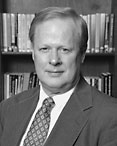The state’s faltering economy would benefit from a new emphasis on science and math learning and teaching, says President Emeritus and University Professor of Science and Engineering James Duderstadt, keynote speaker at the Educating a STEM (science, technology, engineering and mathematics) Workforce summit from 8 a.m.-4:30 p.m. today (May 21) in the Johnson Rooms at the Robert H. Lurie Engineering Center.

“We all know the challenges Michigan has been having the last several years,” Duderstadt says, adding some are ranking the state’s economic potential as last in the nation. “We are clearly the basket case of the global economy.”
The summit grew out of Duderstadt’s “Road Map to Michigan” Report, which decried the state of science and technology education in Michigan. The goal of the summit is to bring together U-M faculty to report on science education research, and to plan steps to improve science education.
Duderstadt notes that both the president and Congress are advancing measures to boost science learning and teaching, following recommendations from national leaders in the sciences.
The attention from national leaders follows several studies that find U.S. students falling behind in science and math capabilities. “Universities are not turning out people that can teach in those STEM areas,” Duderstadt says.
Last year, President George Bush announced an American Competitiveness Initiative that commits $5.9 billion in fiscal year 2007 to increase investments in research and development, strengthen education, and encourage entrepreneurship. Last month, the U.S. Senate passed the America Competes Act, which would double the authorized funding for the National Science Foundation in five years and sets the Department of Energy Office of Science on a path to double over 10 years, among other measures.
“We need to create a similar effort at the state level,” Duderstadt says. He adds that while Michigan produces more teachers than any other state, comparatively few are qualified to teach in the sciences. “We’ve got to align our teacher workforce with our needs in the state.”
Conference organizers note that U-M has a rich history and a wealth of resources to take on the challenge of educating a STEM workforce, with departments and related professional schools ranked among the best in the country. The University’s researchers in the social sciences and education are well known for their studies in career development and educational issues, and intervention efforts such as the Women in Science and Engineering (WISE) Program and the Minority Engineering Program Office (MEPO) have documented success in the recruitment and retention of students in STEM fields and are among the oldest programs in the country.
They say the challenge in creating a coherent strategic effort is the identification, coordination, and dissemination of this vast array of resources and knowledge. In the large decentralized university structure, there are many pockets of individuals working on STEM workforce issues, but with little collaboration or even awareness of others. The University community hasn’t had the opportunity to systematically gather all the knowledge and disseminate it in a user-friendly format.
Participants are scheduled to share their research regarding STEM workforce development and issues that play a role in student career choices, interest, achievement, retention and persistence in the STEM disciplines.
Sponsors are the College of Engineering, the Office of the Vice President for Research, the Institute for Research on Women and Gender, and the Institute for Social Research.

